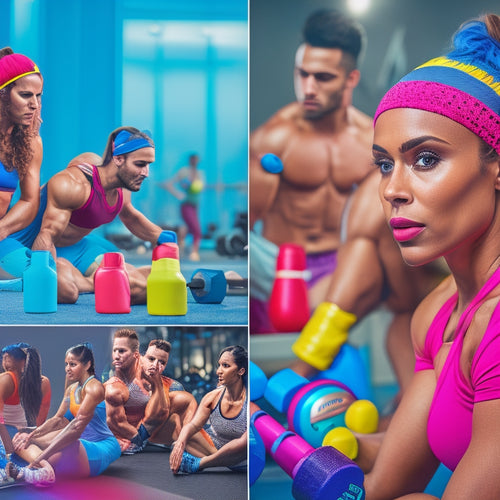What Fuels a Dancer's Body for Weight Loss?
Share
As a dancer seeking to lose weight, you're likely aware that your body requires a specific combination of macronutrients, hydration, and whole foods to fuel your high-energy performances and support your weight loss goals. Carbohydrates provide a primary energy source, while protein supports muscle building and repair. Healthy fats, like omega-rich foods, also play an essential role in energy production. Proper hydration with water and electrolytes is essential for peak energy production and weight loss. By fueling your body with the right nutrients, you'll be able to take your dancing to the next level - and discover the secrets to maximizing your weight loss potential.
Key Takeaways
• A balanced diet with carbohydrates, protein, and healthy fats fuels a dancer's body for optimal energy production and weight loss.
• Protein-rich foods, such as lean meats and fish, support efficient calorie burning and muscle repair.
• Complex carbohydrates, like whole grains and fruits, provide sustained energy release and support weight loss goals.
• Healthy fats, including avocado and nuts, support weight loss and provide an important energy source for dancers.
• Proper hydration with water and electrolytes is essential for energy production, nerve function, and optimal performance.
Macronutrients for Energy Production
As you fuel your body for peak dance performance, what macronutrient combination will provide the energy you need to power through those grueling rehearsals and performances? The answer lies in the perfect blend of carbohydrates, protein, and fat.
Carbs are your body's go-to energy source, converted into glycogen and stored in muscles and liver for later use. When you're dancing, your body taps into glycogen storage, releasing energy through anaerobic and aerobic energy pathways.
Protein, on the other hand, helps build and repair muscle tissue, ensuring you can keep on dancing. Fat is your body's secondary energy source, kicking in when carbs are depleted. A balanced diet with the right macronutrient ratio will optimize your energy production, delaying fatigue and boosting performance.
Hydration for Optimal Performance
As you fuel your body for peak performance, don't overlook the essential role of hydration.
You need water to enhance your energy levels and support your body's functions, and electrolytes to maintain a delicate balance of fluids and minerals.
Water for Energy Boost
Proper hydration fuels your body's energy production, allowing you to tackle even the most demanding dance routines with vigor and precision. As a dancer, you know that a single misstep can throw off your entire performance. That's why it's essential to prioritize hydration to maintain your energy levels.
You see, water makes up about 60% of your body, and even mild dehydration can cause fatigue, dizziness, and decreased performance.
To optimize your hydration, focus on water quality. Aim for alkaline water with a pH level between 8 and 9.5 to help your body function at its best. Additionally, consider incorporating hydrotherapy into your routine. Water-based exercises can help improve your flexibility, strength, and overall performance. Plus, it's a great way to recover from a tough dance session!
Electrolytes for Balance
You're about to take your hydration to the next level by balancing your electrolyte levels, which can make all the difference in your dance performance.
Electrolytes, like sodium, potassium, and calcium, regulate various bodily functions, including nerve and muscle function. When you sweat, you lose these essential minerals, leading to an electrolyte imbalance. This imbalance can cause muscle cramps, fatigue, and dizziness - not exactly what you want during a high-energy dance routine!
To avoid this, consider incorporating electrolyte supplements into your hydration routine. These supplements can help replenish lost electrolytes, ensuring your body functions at its best. Look for supplements containing essential electrolytes like sodium, potassium, and calcium.
You can also consume electrolyte-rich foods like bananas (potassium) and avocados (potassium and magnesium). Remember, a balanced electrolyte level is vital for peak performance.
Whole Foods for Belly Dancers
Your body, as a belly dancer, relies on whole foods to fuel your high-energy performances and support your weight loss goals. Whole foods provide the essential nutrients, fiber, and antioxidants that help you power through those intense dance sessions and shed unwanted pounds.
When it comes to whole foods, spice selection is vital. Incorporating spices like cumin, coriander, and turmeric into your meals not only adds flavor but also boosts metabolism and aids digestion.
Food culture plays a significant role in shaping your dietary habits. As a belly dancer, you're likely drawn to Middle Eastern and North African cuisines, which emphasize whole grains, fruits, and vegetables. These foods are rich in complex carbohydrates, vitamins, and minerals that support energy production and weight loss.
By embracing whole foods and incorporating them into your diet, you'll be well on your way to achieving your weight loss goals and performing at your best.
Boosting Metabolism With Protein
As you fuel your body with whole foods, you can further accelerate your weight loss journey by incorporating protein-rich foods that boost your metabolism, helping you burn calories more efficiently and power through intense dance sessions. Protein takes more energy to digest, which increases your resting metabolic rate, leading to weight loss.
Timing is everything, so aim to consume protein within 30-60 minutes after your dance session to aid in muscle repair and growth. This is particularly important for dancers, as it helps to rebuild and strengthen your muscles, reducing the risk of injury.
Aim for 1.2-1.6 grams of protein per kilogram of body weight daily, spread out over 3-5 main meals and 2-3 snacks. Good sources of protein include lean meats, fish, eggs, dairy, legumes, and nuts.
Don't be shy to get creative with your protein intake – add some protein powder to your smoothie or whip up a protein-packed omelette to keep you fueled and dancing all day long!
Complex Carbohydrates for Energy
As a dancer, you need complex carbohydrates to fuel your high-intensity performances and maintain energy levels throughout your busy schedule.
You'll benefit from consuming energy-rich foods such as whole grains, fruits, and vegetables, which provide sustained energy and support your overall health.
Fuel for Performance
Dance performances demand high-intensity energy, and complex carbohydrates are the primary fuel source that powers your movements. As a dancer, you need a steady supply of energy to perform intricate steps, leaps, and turns. Complex carbohydrates, found in whole foods like brown rice, quinoa, and whole-grain bread, provide sustained energy release, delaying fatigue and maintaining your performance level.
These complex carbs also support your mental clarity, allowing you to focus on perfecting your choreography. When you fuel your body with complex carbs, you're more likely to experience improved concentration and reduced mental fogginess.
Additionally, a diet rich in complex carbohydrates promotes gut health, which is essential for a robust immune system and efficient digestion. A healthy gut microbiome ensures that you're absorbing the nutrients you need to power your performances.
Energy-Rich Foods
You'll want to make whole, unprocessed foods like sweet potatoes, oats, and whole-grain cereals staples in your diet, as these energy-rich foods provide a slow and sustained release of complex carbohydrates for peak energy production. These foods are like the Energizer Bunny of carbohydrates - they keep going and going!
By fueling your body with complex carbs, you'll experience a steady supply of energy, which is perfect for those high-intensity dance sessions. And, as an added bonus, whole foods tend to be lower in caloric density, making it easier to maintain a healthy weight.
When it comes to food combining, pair complex carbs with lean protein sources like chicken or fish to keep you full and satisfied. This winning combo will help you power through even the most challenging dance routines.
Healthy Fats for Weight Loss
Your body relies on essential fats as an important energy source to fuel your dance sessions and support your weight loss goals. As a dancer, you need healthy fats to keep your energy levels high and your weight loss journey on track. But, not all fats are created equal! You want to focus on consuming healthy fats that support your body's needs.
Fat absorption is key to getting the most out of your healthy fats. You see, when you eat healthy fats, your body absorbs them and uses them for energy or stores them for later. The goal is to strike an omega balance, where you're getting the right ratio of omega-3 and omega-6 fatty acids. This balance is essential for reducing inflammation, improving heart health, and supporting weight loss.
Incorporating healthy fats into your diet can be as simple as adding nuts, seeds, avocados, and fatty fish to your meals. These foods aren't only delicious but also packed with nutrients that support your dance performance and weight loss goals.
Electrolytes for Proper Hydration
Proper hydration relies on a delicate balance of electrolytes, essential minerals that regulate fluid balance, nerve function, and muscle contractions, all essential for top dance performance and weight loss.
As a dancer, you know that sweating is an inevitable part of the job. But did you know that excessive sweating can lead to an electrolyte imbalance? When you lose too many electrolytes, your body's delicate balance is disrupted, affecting your performance and weight loss goals.
A high sweat rate can deplete your electrolyte stores, causing muscle cramps, fatigue, and dizziness. This can be a major setback for dancers who need to be at the top of their game.
To avoid an electrolyte imbalance, make sure to replenish lost electrolytes by consuming electrolyte-rich foods and drinks, such as bananas, avocados, and coconut water. By maintaining a healthy balance of electrolytes, you'll be able to perform at your best, lose weight effectively, and avoid those pesky muscle cramps that can ruin your dance routine.
Post-Workout Snacks for Recovery
After a strenuous dance session, your body cries out for nutrients to repair and rebuild muscle tissue, making the timing and composition of your post-workout snack essential for ideal recovery. A well-timed snack can help reduce muscle soreness, replenish energy stores, and support muscle growth.
So, what makes a great post-workout snack?
Here are some snack timing strategies and dance-friendly options to get you started:
- Consume a snack within 30-60 minutes after your dance session, when your body is most receptive to nutrient uptake.
- Opt for snacks with a mix of carbohydrates and protein, such as a banana with almond butter or a protein shake with fruit.
Dance-friendly bars like RXBAR or Quest Bar provide a convenient and balanced snack option.
- Aim for snacks with a 3:1 or 4:1 carbohydrate-to-protein ratio, such as a handful of trail mix with nuts and dried fruit.
- Experiment with different snack timings and compositions to find what works best for your body and dance style.
Meal Planning for Busy Dancers
As a busy dancer, you need a meal planning strategy that fuels your body for peak performance, and a well-structured plan can help you make healthy choices even on the most hectic of days. With a packed schedule of rehearsals, performances, and classes, it's easy to grab whatever's quickest, but that can lead to energy crashes and weight gain.
To stay on track, prioritize time management by setting aside 30 minutes each week to plan and prep your meals. This will help you avoid relying on convenience foods and make sure you're getting the nutrients you need.
Focus on portion control by measuring out serving sizes and packing snacks in advance. Aim for balanced meals with lean protein, complex carbs, and healthy fats to keep you full and focused. Consider meal prepping on the weekends or one day a week, and store individual portions in containers for easy grab-and-go.
Frequently Asked Questions
Can I Eat Whatever I Want if I Exercise Enough?
"Did you know 67% of Americans believe exercise cancels out poor eating habits? Sorry, but nope! You can't outrun a bad diet. To lose weight, you need Calorie Balance and Portion Control, not just intense exercise sessions; focus on both for a leaner you!"
How Much Water Should I Drink During a Dance Performance?
During a dance performance, you should drink 8-10 ounces of water every 15-20 minutes to maintain peak hydration levels and electrolyte balance, ensuring your body's water-electrolyte harmony isn't disrupted, leaving you feeling like a dancing queen!
Do I Need to Cut Out Carbs to Lose Weight as a Dancer?
You don't need to cut out carbs entirely, but try macro counting and carb cycling to optimize your diet for weight loss as a dancer; it's about balance, not elimination.
Will Protein Shakes Help Me Lose Weight and Build Muscle?
You're wondering if protein shakes can be your weight loss and muscle-building BFFs? Yes, they can! Post-workout recovery and daily supplementation with protein shakes can help you build lean muscle and boost metabolism, supporting your weight loss goals.
Can I Skip Meals to Speed up Weight Loss as a Dancer?
Did you know 69% of dieters regain lost weight within a year? Skipping meals as a dancer can lead to nutrient deficiencies, triggering hunger hormones like ghrelin, making you hungrier, and ultimately, slowing down your metabolism.
Related Posts
-

3 Best Online Tools for Organized Dance Makeup Artists
You need online tools to streamline your workflow and deliver exceptional service to your dance clients. For seamless...
-

Top Performance Headbands for Fitness Enthusiasts
When you're looking for top performance headbands, focus on options that combine advanced moisture-wicking fabrics wi...
-

Instant Download Card for Dance Recital Performances
Instant download cards are a convenient way to commemorate dance recital performances, providing a seamless solution ...


